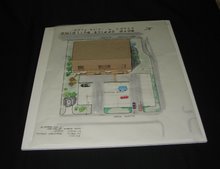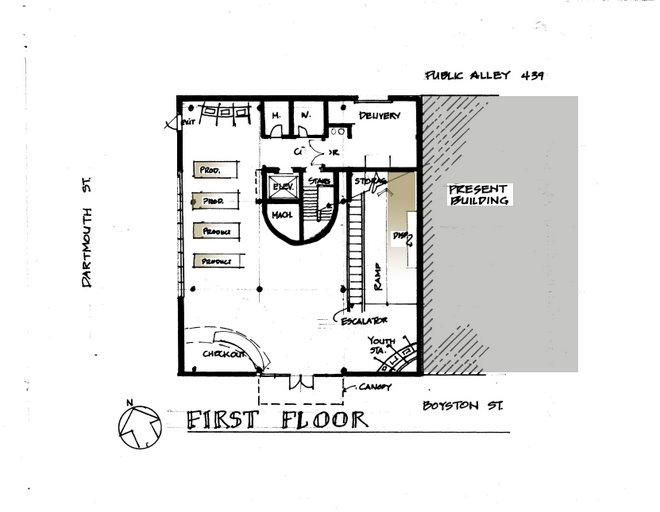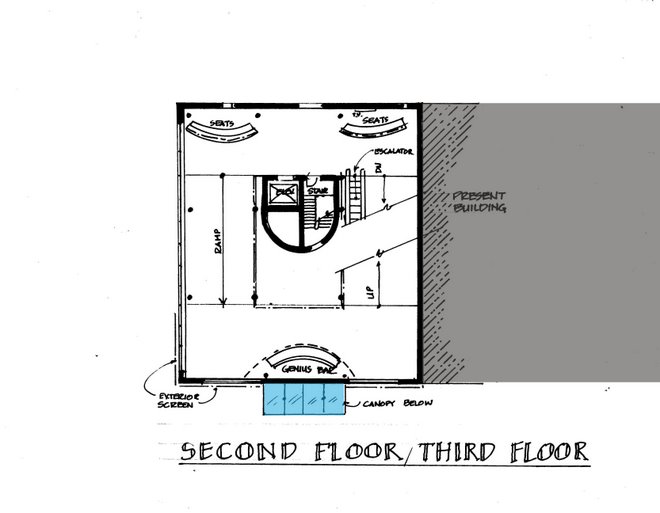Jane Jacobs proposed a radical departure from the planning theories of cities in her time. Her ideas pertaining to city planning were more humane than others5. She approached the idea of city building from a smaller, yet important scale. She emphasized the humanistic approach to neighborhoods as opposed to the then common theory of urban renewal or destructions of neighborhoods. This paper will explore the application of her concepts of diversity as it directly related to the new Virginia Beach Town Center under constructed in my city of Virginia Beach, Virginia. The Town Center has attempted to bring condition of diversity by means other than suggested by Jane Jacobs. While new elements are changing the way cities grow and change there is still relevance to what Jane Jacobs has said about diversity and its application to urban life1.
At full capacity, The Town Center will have a living and working population. The heart of this new mixed-use “main street” style development located at the core of the Central Business District will be cultural, business and retail activities. Spanning across 17 city blocks, The Town Center will provide a mix of upscale retail, luxury residential, Class A offices, a business class hotel and an array of restaurants.6
“The four elements of diversity attributed to Jane Jacobs are: First, there must be a Specific District, which is a designated area having two or more primary functions. Second, The streets must be short with small blocks and must be used. Third, a mingling of old and new buildings must be present and provide differing economic yields. And fourth, their must be a dense concentration of people that causes a mingle of different cross activities on different schedules.” 2 I will treat each of the four factors of diversity which Jane Jacobs proposes as they pertain to the Virginia Beach Town Center.
The Town Center, as it is know, is a mixture of several primary uses. Entertainment, Dwelling, Business and Retail spaces are the planned primary uses. The mixture of businesses and organizations take a wide ranges and hours of operation. For example, the Performing Arts Center will have performances when it opens in November of 2007 when some of the retail businesses are closed. However, the restaurants and food establishments adjacent to Arts Center will be open to service the activities of the theater crowd during those hours. Likewise during normal business hours when many of government and business people have access to hotels, the 300 residential units, cafes and restaurants. The hotel and residential functions will be in the two tallest buildings in Virginia have the highest densities. These cross activities cause the main streets to be occupied with people at various times of the day and night. The characteristic activities, in say, a mall or shopping center are here extended by the entertainment uses at the Arts Center. This is in line with the tenant of Jane Jacobs who insisted on cross uses as a point of diversity 3 .
Another important factor of commercial diversity is the assembly of tenants for the commercial activities. The section has been done through a single leasing agent and of all the listing of retailers in the entire 17 block area only 38% are a single proprietor, while a full 62% are retailers which are part or fully owned by a chain franchises. Likewise the eating establishments are a solid 86% chain franchises. Many of these franchises got their start outside the state. Again, this is not the development of local activity, which would be what Jane Jacobs sought but rather an agglomerate enterprises of many franchised businesses that are rooted in the area and have a history based on their efforts 7 4.
It must be mentioned that the partnering of government and private enterprise in this development has been a major boost to the activity of the center. By locating government sponsored events and offices in the Town Center it increases the diversity, which is all part of what Jane Jacobs emphasized 8. Until the creation of Town Center all the functions took place at the oceanfront or in the Municipal complex, both of which are remote for most of the city residents. The municipal complex was Historic and in a rural location not convenient to all citizens5. This indicates the shift from rural to urban as a community.
The second major concurrence with Jane Jacobs by the Town Center is the short streets and city blocks9. The Town Center has rectangular block formations, however, they are short and contain vistas that are punctuated by fountains and views, and make walking easy among the buildings. Access to the centrally located free public parking is also convenience. By providing safe and convenient parking the ability to reach the center is an incentive that the older centers such as Norfolk, Portsmouth or Hampton do not have in the region. The block lengths are roughly twice its width. This condition makes streets economical in terms of pedestrian walking and gives shopkeepers exposure from several different directions at street level. The varying schedules provides cross activity, which was important diversity factor. Unlike the example of people in lower Manhattan who worked in the area left at 5:00 p.m, which Jane Jacobs said, created a “deathlike stillness”, the Town Center has activities for both residents and outsiders simultaneously`10. These uses insure different activity on the street during all hours. The ability to browse a book over a coffee or attend a show or play has kept the level constant during non-business hours as well as during business hours. The short blocks have aided the diversity of the center. This underscores the relevance of Jane Jacobs’ ideas and again confirms the need for it as a future factor of development.
The third important aspect of diversity that is perhaps the weakest link in the application to the New Town Center is the mingling of old and new buildings.
While the Town Center is a new development the idea that a mixture of old and new should coexist and provide context is a freedom. Jane Jacobs mentions the “mingle of buildings that vary in age and condition, including a good portion of the old ones.”1 She emphasizes the high cost of total new construction. By creating new and removing the old facilities support functions that help the main functions are removed. Where normally people could go into the secondary or supportive spaces that are being eliminated at the New Town Center. While the Performing Arts Centers is a new faculty, persons at the lower economic ends of income who wish to support that primary activity must reside outside the town center because their is no moderate or Low cost living or dining places. These secondary spaces such as housing, studios, specialty craftsmen are missing. With a lack of the building mixtures in the Town Center the lack of diversity is evident. The affordability of the condominiums and apartments units are targeted to be sold or rented to upper income of people that would use the Entertainment, Business or commercial spaces in the center. Only small portions of the people who work in the shops or house keeping staff have any accommodation in the Town Center. As a result the long-range plan to emphasize new rather than retain a mix, as proposed by Jane Jacobs, reference the economic bias toward completely new facilities at the expense of a few extant structures or sites is not a positive aspect of the development. Jane Jacobs has mentioned “ mingling of old buildings, with consequent mingling in living costs and tastes, are essential to get diversity and stability in residential populations, as well as diversity in enterprise”6. From what is understood about the future of the Virginia Beach Town Center and what buildings are currently there will be removed. The lack of mingling will mean the stock of buildings will be a more expensive first cost to those who occupy its spaces. This is one weakness in the town center scheme of development, which may prove more important as the center ages.
Finally, Their idea which is present and discussed very toughly in her book, Jane Jacobs has indicated the density should be somewhere between 200 11 and 963 12persons per acres. The density of persons in the New Town center will be a total of 24,00 people in an area of approximately 30 acre. The conurbation of this type of density will provide an activity level comparatively like many well established city centers. There are not a lot of open spaces for large playgrounds at ground level or parks with large trees. The residential densities of the projects will concentrate in three of the seventeen blocks.
In conclusion
The long term success of the Virginia Beach Town Center will be found in the ability to overcome its flaws, which are: the mixture of old and new buildings, mixtures of uses and densities. The underlying importance on new buildings, the fiber of a community, and not having enough older housing or commercial space are all immediate concerns. The emphasis on upper income residence and entertainment are hardly enough to sustain a normal city such as Boston or New York, so why should it work in Virginia Beach? It is because the Town Center is new development, which uses the adjacencies of location, high residential densities and growth to encourage development. At the time of this writing growth and demand for the retail spaces has been exceptionally high. Restaurants in the are constantly opening to good publicity and have shown the ability to encourage high demand event before the opening of the Cultural Arts Center designed by Philip Johnson and Alan Ritchie.
The Town Center Project in Virginia Beach though the eyes of Jane Jacobs would seem to be lacking in diversity and be artificially inflated1. The fact that for the last five years the Town Center Project has been so successful that the areas around the Town Center are beginning to show an increase in activity. A development of Town Center West, which is beginning, will soon have low rise commercial and offices. With the object of maintaining momentum those involved in the Town Center project will be hard pressed to maintain a supply of new spaces while not overbuilding. It is a complicated mix of resources and market that will have to be considered. In my conversation with Armada Hoffler the cost of producing all the phases for all the uses will be about $114 per square foot, which in today’s construction standard is a relative bargain. The fact that the original buildings were not of the quality of the new construction also plays heavily in why things were built new.
All of the factors that Jane Jacobs touched on in her thesis have meaning in the Virginia Beach Town Center. The emulation of the older and more diverse City Center proved that the essential quality of City neighborhoods must be a product, which leads to holistic lifestyles. One is encouraged by the success of the Town Center project. It is a bold move by local leaders to expend the resources they have thus far complete and created a training center. However, the relationship to the exact tenants of Jane Jacobs ideas of a” Specific District, small blocks mingling of old and new buildings and dense concentration of people” 2can not guarantee success in a changing world. Diversity is the result of slow agglomeration over long periods. Today we have the hard reality that the city center must be used in order for it to be successful. Marketing and economic reality must be present and balanced the physical amenities for a project to work7. What that means is that diversity must be guided and monitored aggressively. The beginning of the center has developed over half of the usable land space. Ultimately, the final test will be whether the diversity that was created can withstand the years ahead. If Jane Jacobs four tenets of diversity are strictly adhered then The Town Center is doomed to failure. The current conditions would prove all this is wrong. And only time will tell. If urbanism in the midst of a suburban community of Virginia Beach is able to sustain growth it may be a bright spot in a region. If it continues to be a success it will prove a new avenue to help encourage other centers. If it does not, the factors will remain a testament to the diversity that Jane Jacobs proposed. Jane Jacobs could not foresee the shift in her ideas of diversity toward one that emphasizes healthy Lifestyles as a changing sociological trend. We need to wait and see if the trend is short-term or long-term element of diversity.
While I feel that the four areas of diversity are present in the Virginia Beach Town Center, it does not strictly adhere to what was proposed by Jane Jacobs. In closer scrutiny the serious discontinuity exists between a multifaceted neighbor hood or city center between what was observed and recorded in her book, The Life and Death of Great American Cities1. Reality is that new tools are needed for a new center. The partnering in this center is a risk that spreads responsibility evenly. Diversity is not a planned or deliberate part of this development, however, it is evolving as important to continued growth. The center has moved beyond the ‘initial’ phase of being trendy and has developed a place in the city vocabulary of places. The center continues to grow with surprising success and activity at all hours of the day and night. When the new Cultural Arts Center coming online in November of this year a greater range of hours will add evening attraction beyond what it is current. While all this seems to be occurring in an orderly manner, it is not the result of planned thoughtful designs but though a market driven response to the need to create a focus. The Town Center continues to be successful and will be an asset to the establishing of the City of Virginia Beach as a city center.
1 Jacobs, Jane, The Life and Death of Great American Cities. 1961, New York, Vantage Books Edition, December 1992
2 Ibid, 150
3 Ibid, 153
4 Interview with Danya Bushey, Marketing Director of Amada Hoffler, by the author 6/20/2007
5 de Botton, Alain, The Architecture of Happiness. 2006Hamish Hamilton of Penguin Books
6 SOURCE: Excerpted from "Who Rules America Now?" by G. William Domhoff, 1983, publ. by Prentice-Hall, Inc. (pgs. 173-184)
7 Interview with Danya Bushey, Marketing Director of Amada Hoffler, by the author 6/20/2007
8 Interview with Amy Cherry of Divaris Real Estate, an interview by the author, 15 June, 2007
9 Jacobs, Jane, The Life and Death of Great American Cities. 1961, New York, Vantage Books Edition, December 1992 page 179
10 Ibid, 206
11 Ibid, 214
BIBLIOGRAPHY
Bacon, Edmund, Planner for City of Philadelphia, interview by the author October
15, 1984.
Bushey, Danya, Marketing Director of Armada Hoeffler, interview by the author,
Virginia Beach, Virginia, 20 June 2007.
De Botton, Alain, The Architecture of Happiness, Hamish Hamilton of Penguin
Books, London, England, 2006
Domhoff, G. William,” Who Rules America Now? Power, Politics and Social
Change (5th Edition, McGraw-Hill, New York, 2005,
Http.sociology.ucsc.edu
Jacobs, Jane, Life and Death of Great American Cities, New York, Vintage
Books, A Division of Random House, Inc., December 1992
Virginia Town Center, Website www.vabeachtowcenter.com/look in “About the
Town Center”.
Saturday, June 30, 2007
Subscribe to:
Post Comments (Atom)






No comments:
Post a Comment